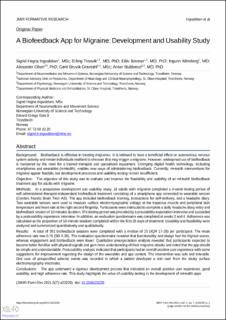| dc.description.abstract | Background: Biofeedback is effective in treating migraines. It is believed to have a beneficial effect on autonomous nervous system activity and render individuals resilient to stressors that may trigger a migraine. However, widespread use of biofeedback is hampered by the need for a trained therapist and specialized equipment. Emerging digital health technology, including smartphones and wearables (mHealth), enables new ways of administering biofeedback. Currently, mHealth interventions for migraine appear feasible, but development processes and usability testing remain insufficient. Objective: The objective of this study was to evaluate and improve the feasibility and usability of an mHealth biofeedback treatment app for adults with migraine. Methods: In a prospective development and usability study, 18 adults with migraine completed a 4-week testing period of self-administered therapist-independent biofeedback treatment consisting of a smartphone app connected to wearable sensors (Cerebri, Nordic Brain Tech AS). The app included biofeedback training, instructions for self-delivery, and a headache diary. Two wearable sensors were used to measure surface electromyographic voltage at the trapezius muscle and peripheral skin temperature and heart rate at the right second fingertip. Participants were instructed to complete a daily headache diary entry and biofeedback session of 10 minutes duration. The testing period was preceded by a preusability expectation interview and succeeded by a postusability experience interview. In addition, an evaluation questionnaire was completed at weeks 2 and 4. Adherence was calculated as the proportion of 10-minute sessions completed within the first 28 days of treatment. Usability and feasibility were analyzed and summarized quantitatively and qualitatively. Results: A total of 391 biofeedback sessions were completed with a median of 25 (IQR 17-28) per participant. The mean adherence rate was 0.76 (SD 0.26). The evaluation questionnaire revealed that functionality and design had the highest scores, whereas engagement and biofeedback were lower. Qualitative preexpectation analysis revealed that participants expected to become better familiar with physical signals and gain more understanding of their migraine attacks and noted that the app should be simple and understandable. Postusability analysis indicated that participants had an overall positive user experience with some suggestions for improvement regarding the design of the wearables and app content. The intervention was safe and tolerable. One case of prespecified adverse events was recorded in which a patient developed a skin rash from the sticky surface electromyography electrodes. Conclusions: The app underwent a rigorous development process that indicated an overall positive user experience, good usability, and high adherence rate. This study highlights the value of usability testing in the development of mHealth apps. | en_US |

